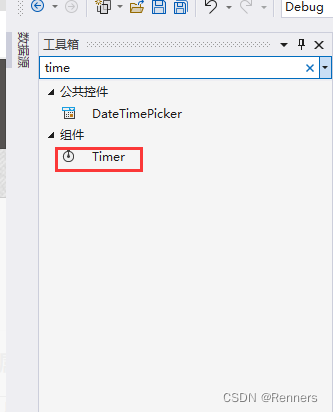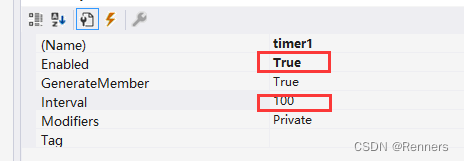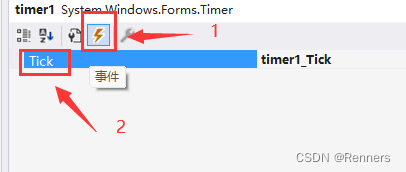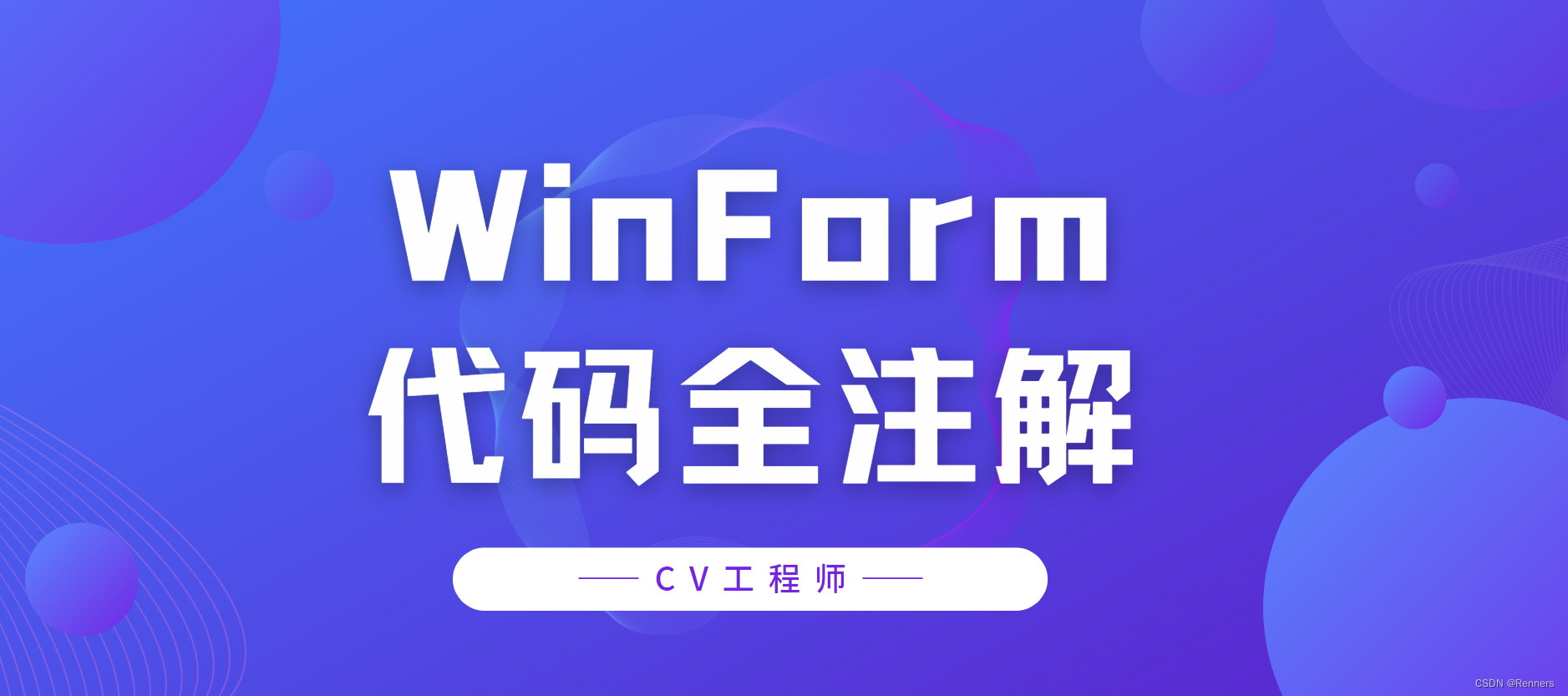一、窗体透明全屏
全屏代码实现,在Form1_Load中配置如下,或者直接配置Form1属性的值
this.TopMost = true;//设置窗体至于顶层
this.FormBorderStyle = FormBorderStyle.None; //设置窗体为无边框样式
this.WindowState = FormWindowState.Maximized; //最大化窗体
this.Opacity = 0.8; //透明度,设置为0时背景透明,0~1区间为半透明,半透明时鼠标不可穿透.二、鼠标穿透
设置了窗体透明后,如果需要透过窗体操作桌面上的应用,则需要设置鼠标穿透,鼠标穿透实现代码如下:
Form1_Load中
//设置窗体透明
SetWindowLong(Handle, GWL_EXSTYLE, GetWindowLong(Handle, GWL_EXSTYLE) |
WS_EX_TRANSPARENT | WS_EX_LAYERED);
SetLayeredWindowAttributes(Handle, 0, 128, LWA_ALPHA);
//设置窗体透明
#region user32.dll
public const Int32 SPIF_UPDATEINIFILE = 0x1;
public const Int32 SPI_SETWORKAREA = 47;
public const Int32 SPI_GETWORKAREA = 48;
public const Int32 SW_SHOW = 5;
public const Int32 SW_HIDE = 0;
[DllImport("user32.dll", EntryPoint = "ShowWindow")]
public static extern Int32 ShowWindow(Int32 hwnd, Int32 nCmdShow);
[DllImport("user32.dll", EntryPoint = "FindWindow")]
private static extern Int32 FindWindow(string lpClassName, string lpWindowName);
[DllImport("user32.dll", EntryPoint = "SystemParametersInfo")]
private static extern Int32 SystemParametersInfo(Int32 uAction, Int32 uParam, ref Rectangle lpvParam, Int32 fuWinIni);
// 要想使窗口具有透明效果,需要设置窗口WS_EX_LAYERED
[DllImport("user32.dll", EntryPoint = "GetWindowLong")]
public static extern long GetWindowLong(IntPtr hwnd, int nIndex);
[DllImport("user32.dll", EntryPoint = "SetWindowLong")]
public static extern long SetWindowLong(IntPtr hwnd, int nIndex, long dwNewLong);
[DllImport("user32", EntryPoint = "SetLayeredWindowAttributes")]
public static extern int SetLayeredWindowAttributes(IntPtr Handle, int crKey, byte bAlpha, int dwFlags);
const int GWL_EXSTYLE = -20;
const int WS_EX_TRANSPARENT = 0x20;
const int WS_EX_LAYERED = 0x80000;
const int LWA_ALPHA = 2;
#endregion三、文件读取
string PathStrValue = System.Windows.Forms.Application.StartupPath; //获取程序的绝对路径
var url = PathStrValue + "测试文件.txt"; //拼接【测试文件.txt】文件所在地址
if (File.Exists(url)) // 判断路径是否存在
{
//此处可执行业务操作,若存在则读取文件内的内部,并转为string类型
var openType = File.ReadAllBytes(url);
string openText = Encoding.Default.GetString(openType);
//此处可执行业务操作,若存在则读取文件内的内部,并转为string类型
}
else {
//若判断程序不存在,则直接创建文件并写入内容
StreamWriter SW = File.CreateText(url);
SW.Write("这里为写入的内容"); //此处为自定义写入内容
SW.Flush();
SW.Close();
//若判断程序不存在,则直接创建文件并写入内容
}四、开机自启动
//public Form1()中
SetMeAutoStart(true); //自动启动
/// <summary>
/// 快捷方式名称-任意自定义
/// </summary>
private const string QuickName = "FullScreen1";
/// <summary>
/// 自动获取系统自动启动目录
/// </summary>
private string systemStartPath { get { return Environment.GetFolderPath(Environment.SpecialFolder.Startup); } }
/// <summary>
/// 自动获取程序完整路径
/// </summary>
private string appAllPath { get { return Process.GetCurrentProcess().MainModule.FileName; } }
/// <summary>
/// 自动获取桌面目录
/// </summary>
private string desktopPath { get { return Environment.GetFolderPath(Environment.SpecialFolder.DesktopDirectory); } }
/// <summary>
/// 设置开机自动启动-只需要调用改方法就可以了参数里面的bool变量是控制开机启动的开关的,默认为开启自启启动
/// </summary>
/// <param name="onOff">自启开关</param>
public void SetMeAutoStart(bool onOff = true)
{
if (onOff)//开机启动
{
//获取启动路径应用程序快捷方式的路径集合
List<string> shortcutPaths = GetQuickFromFolder(systemStartPath, appAllPath);
//存在2个以快捷方式则保留一个快捷方式-避免重复多于
if (shortcutPaths.Count >= 2)
{
for (int i = 1; i < shortcutPaths.Count; i++)
{
DeleteFile(shortcutPaths[i]);
}
}
else if (shortcutPaths.Count < 1)//不存在则创建快捷方式
{
CreateShortcut(systemStartPath, QuickName, appAllPath, "FullScreen1");
}
}
else//开机不启动
{
//获取启动路径应用程序快捷方式的路径集合
List<string> shortcutPaths = GetQuickFromFolder(systemStartPath, appAllPath);
//存在快捷方式则遍历全部删除
if (shortcutPaths.Count > 0)
{
for (int i = 0; i < shortcutPaths.Count; i++)
{
DeleteFile(shortcutPaths[i]);
}
}
}
//创建桌面快捷方式-如果需要可以取消注释
//CreateDesktopQuick(desktopPath, QuickName, appAllPath);
}
/// <summary>
/// 向目标路径创建指定文件的快捷方式
/// </summary>
/// <param name="directory">目标目录</param>
/// <param name="shortcutName">快捷方式名字</param>
/// <param name="targetPath">文件完全路径</param>
/// <param name="description">描述</param>
/// <param name="iconLocation">图标地址</param>
/// <returns>成功或失败</returns>
private bool CreateShortcut(string directory, string shortcutName, string targetPath, string description = null, string iconLocation = null)
{
try
{
if (!Directory.Exists(directory)) Directory.CreateDirectory(directory); //目录不存在则创建
//添加引用 Com 中搜索 Windows Script Host Object Model
string shortcutPath = Path.Combine(directory, string.Format("{0}.lnk", shortcutName)); //合成路径
WshShell shell = new IWshRuntimeLibrary.WshShell();
IWshShortcut shortcut = (IWshRuntimeLibrary.IWshShortcut)shell.CreateShortcut(shortcutPath); //创建快捷方式对象
shortcut.TargetPath = targetPath; //指定目标路径
shortcut.WorkingDirectory = Path.GetDirectoryName(targetPath); //设置起始位置
shortcut.WindowStyle = 1; //设置运行方式,默认为常规窗口
shortcut.Description = description; //设置备注
shortcut.IconLocation = string.IsNullOrWhiteSpace(iconLocation) ? targetPath : iconLocation; //设置图标路径
shortcut.Save(); //保存快捷方式
return true;
}
catch (Exception ex)
{
string temp = ex.Message;
temp = "";
}
return false;
}
/// <summary>
/// 获取指定文件夹下指定应用程序的快捷方式路径集合
/// </summary>
/// <param name="directory">文件夹</param>
/// <param name="targetPath">目标应用程序路径</param>
/// <returns>目标应用程序的快捷方式</returns>
private List<string> GetQuickFromFolder(string directory, string targetPath)
{
List<string> tempStrs = new List<string>();
tempStrs.Clear();
string tempStr = null;
string[] files = Directory.GetFiles(directory, "*.lnk");
if (files == null || files.Length < 1)
{
return tempStrs;
}
for (int i = 0; i < files.Length; i++)
{
//files[i] = string.Format("{0}\\{1}", directory, files[i]);
tempStr = GetAppPathFromQuick(files[i]);
if (tempStr == targetPath)
{
tempStrs.Add(files[i]);
}
}
return tempStrs;
}
/// <summary>
/// 获取快捷方式的目标文件路径-用于判断是否已经开启了自动启动
/// </summary>
/// <param name="shortcutPath"></param>
/// <returns></returns>
private string GetAppPathFromQuick(string shortcutPath)
{
//快捷方式文件的路径 = @"d:\Test.lnk";
if (System.IO.File.Exists(shortcutPath))
{
WshShell shell = new WshShell();
IWshShortcut shortct = (IWshShortcut)shell.CreateShortcut(shortcutPath);
//快捷方式文件指向的路径.Text = 当前快捷方式文件IWshShortcut类.TargetPath;
//快捷方式文件指向的目标目录.Text = 当前快捷方式文件IWshShortcut类.WorkingDirectory;
return shortct.TargetPath;
}
else
{
return "";
}
}
/// <summary>
/// 根据路径删除文件-用于取消自启时从计算机自启目录删除程序的快捷方式
/// </summary>
/// <param name="path">路径</param>
private void DeleteFile(string path)
{
FileAttributes attr = System.IO.File.GetAttributes(path);
if (attr == FileAttributes.Directory)
{
Directory.Delete(path, true);
}
else
{
System.IO.File.Delete(path);
}
}
/// <summary>
/// 在桌面上创建快捷方式-如果需要可以调用
/// </summary>
/// <param name="desktopPath">桌面地址</param>
/// <param name="appPath">应用路径</param>
public void CreateDesktopQuick(string desktopPath = "", string quickName = "", string appPath = "")
{
List<string> shortcutPaths = GetQuickFromFolder(desktopPath, appPath);
//如果没有则创建
if (shortcutPaths.Count < 1)
{
CreateShortcut(desktopPath, quickName, appPath, "软件描述");
}
}
//自动启动
五、定时器
1、打开工具箱,双击添加tTimer控件

2、设置Timer控件属性值;
Enable:是否启用控件,只有设为“true”,定时器才会运作
Interval:定时间隔,单位是1ms。输入1000,就是1s运行一次定时任务

3、点击属性面板上的Timer事件,双击Tick

即可在timer1_Tick中写定时任务了

六、进程守卫
为了让一个程序长期运行且不被关闭,常规的方法就是写一个windows服务来监听程序是否在运行,如果没运行则自动启动,但是在win7以后微软为了安全性考虑,引入了Session隔离,没有办法通过windows服务启动带界面的程序,就算启动也会显示为后台进程,界面依然不会显示,在网上查询好久之后发现有这两篇文章给出了相对成熟的解决方案:
windows服务创建带界面的窗口进程(穿透Session 0 隔离)_古道青阳的博客-CSDN博客
C#穿透Session隔离--服务调用外部程序(无窗体界面解决)_花北城的博客-CSDN博客_c# 进程隔离
通过以上两篇文章并查询了微软的官方文档后,发现功能可以实现,但是实现起来相对比较复杂,而且在没读透源码的情况下总感觉会有坑,于是我采用了以下思路,既然不能用服务调用带有界面的程序,那就直接让两个程序之间相互调用,实现方式有点类似病毒,除非是在特定硬件上,否则不推荐使用,容易被用户举报;
实现思路:
这里我们把带界面的程序叫做A;另一个用来监控的程序叫做B
1)把应用程序B的界面进行隐藏;不能在界面加载的时候之间使用this.hide(),在某些机型上可能会出现闪一下的情况,我的做法是直接把窗体的属性设置为ShowInTaskBar=false,WindowState=Minimized
当然也可以通过其他方式对窗体进行隐藏,如重新窗体程序的指定事件
2)在程序B和程序A中都引入Timer控件,在程序中B监听程序A,在程序A中监听程序B;如A程序被关闭了,B程序自动启动A,B程序被关闭了,A程序自动启动B;关键代码如下:
//获取进程
Process[] app = Process.GetProcessesByName("你要监听的程序进程名称");
string PathStrValue = System.Windows.Forms.Application.StartupPath; //读取绝对路径
var path = PathStrValue + "你要监听的程序进程名称.exe"; //拼接程序路径
if (app.Length > 0) //判断进程是否在运行
{
}
else
{
if (File.Exists(path)) //判断程序是否存在
{
//启动被监听程序
Process m_Process = new Process();
m_Process.StartInfo.FileName = path;
m_Process.Start();
//启动被监听程序
}
}3)将程序A和程序B所生成的代码(bin文件)放置在同一个文件下即可,运行程序A时,程序B则自动运行
4)以上则完成,若觉得此类方法还是不保险,则直接在窗体关闭事件上加上监听方法,任意窗体关闭都会启动另一个窗体,从而达到程序永远不能被关闭的情况;在此可以在程序上加上开机自动启动,则形成了一个仿病毒程序
附:windows服务实现进程守卫教程:进程守卫(windows服务)
